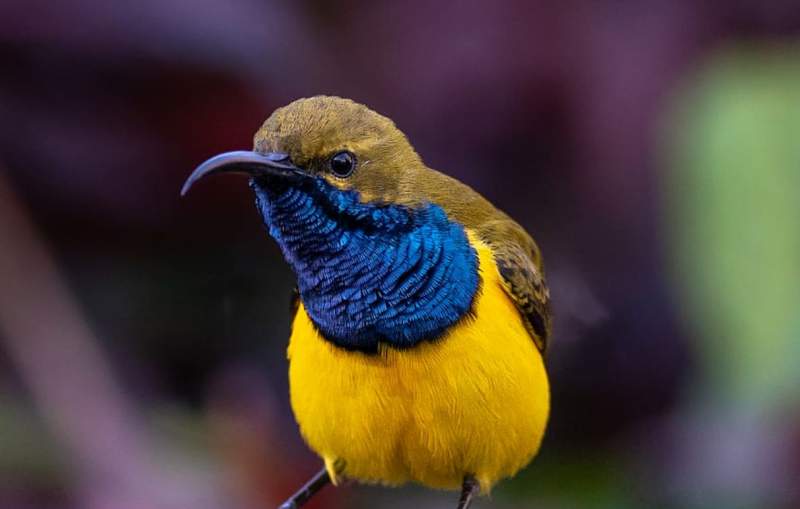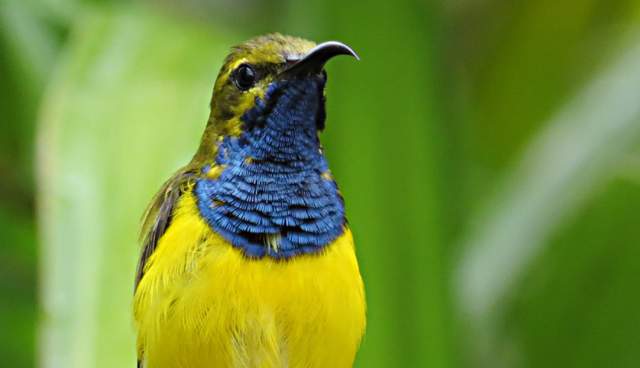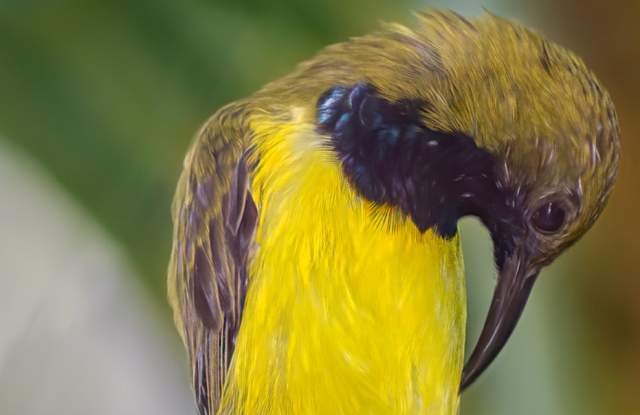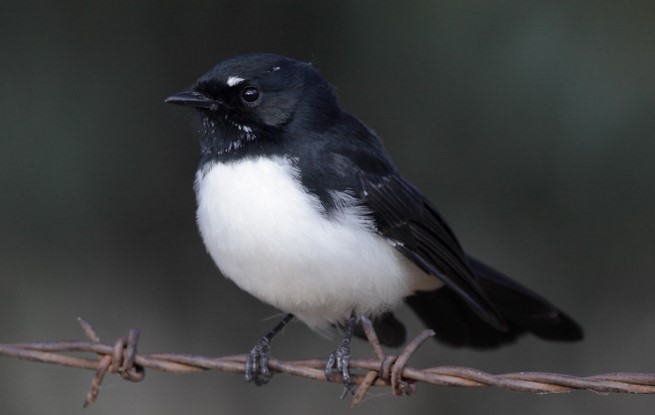The mix of vibrant colors as tiny Yellow-bellied Sunbirds (Cinnyris jugularis) flit about red flowering shrubs with the blue Emperor butterfly (Papilo ulysses), in a tropical Queensland garden is vivid indeed. Only one species of sunbird, the Yellow-bellied, reaches Australia although it is unrelated to hummingbirds.
It is also known as the Olive-backed Sunbird and Yellow-breasted Sunbird. Like honeyeaters, they have long curved bills and protruding brush-tipped tongues for rifling nectar, but their brush structure is different, more quickly toothed, and their tongue edges are rolled to form a complete fine tube, allowing capillary action to absorb nectar. In flight and when feeding, a Yellow-bellied Sunbird makes an animated tzit-tzit-tzit-tzit call. The song consists of a hissing whistle arranged into a trill, which is occasionally followed by descending notes.

In tropical Queensland, sunbirds are equally at home in gardens and mangroves as they are nearby rainforest margins and regrowth, wherever there are nectar-bearing flowers. In search of spiders and insects, the birds actually enter houses and build nests on anything they can find. The birds’ staple diet consists of nectar and spiders, which they pick from webs as they hover, darting here and there to capture them. Different techniques are used by sunbirds to take nectar from different flowers.
They hover and insert their bill in front of small flowers. When flowers are wide and open, they cling to the front, tearing the petals in order to get at the nectar. When the flowers are narrow and trumpet-shaped, they penetrate the base of the corolla in order to access the nectar. A new coast along the Queensland coast may enable the Yellow-bellied Sunbird to expand its range southward. A group of 8 to 10 males congregates before the main breeding season and often invades established pairs’ territories.
Having spent several hours chasing each other and chattering, they suddenly sunk back into a perch and sat in line with heads pointing skyward. As soon as they are in this position, they either fly off or disperse and stay there for a while. A territory holding test or recruitment of females could be the purpose of this display. During nesting and incubation, the female constructs and protects a territory that is protected by the male. During the building process, he offers little assistance to her. Eaves, verandas, and sheds provide shelter from the weather for nests near human habitation.

In the same nest, the birds can rear up to three broods a season; the nest can be used for 15 years. Old nests can be renovated until they fall down; old nests may be used for 15 years. In the first six to eight days following hatching, the female continues to brood and tend the young before the male begins to help. About 100-115 mm in length is the average size.
Olive-green is the color of the male upper parts. Quills of wings dusky-edged olive-yellow; tail dusky tipped with white. Olive-yellow face with brighter yellow lines above and below the eyes. Unlike the underparts, the chin, throat, and upper breast are metallic blue-black, glossed at the edges with a purple tinge; the rest are deep yellow, washed orange on the sides. The eye color is dark brown. Legs and bill are black. There is no orange tinge on the breast of the female bird; her underparts are plain deep yellow. Immature birds are a little duller yellow below. A metallic blue line appears on the throat of immature males.
Breeding and nesting take place from July to March, but nests are built throughout the year. A long, spindle-shaped nest made of bark, plant fibers, dead leaves, grass, cobwebs and cocoons, and strings of caterpillar droppings. The nest is lined with plant down and feathers. Trees, power lines, clotheslines, and eaves are the places where the nest is hung.
Yellow-bellied Sunbird usually lays two eggs, rarely three; smooth, lustrous green-grey to ash-white, covered with brown freckles, sometimes forming a band on the larger end; oval shape, about 17 x 12 mm. Females are responsible for incubation.
Yellow-bellied Sunbirds are found in rainforest edges, mangroves, and suburban gardens in coastal Queensland from Cape Kirk to about Gladstone. Also from the Andaman Islands to New Guinea and the Bismark archipelago in southeastern Asia. There are about 23 races; one is found in Australia.
Read More – Purple Sunbird vs Purple-rumped Sunbird







